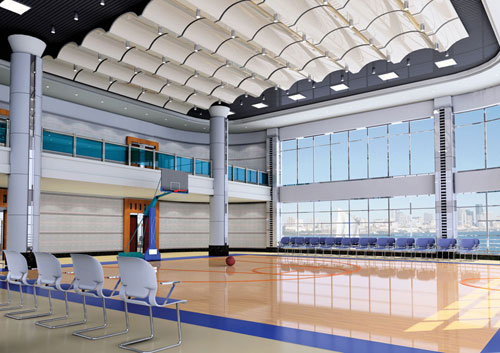Whole System Acoustical Treatments
Some recently published work (February 2012) by Lindsay Baker at the University of California, Berkeley working with the Center for Green Schools at USGBC, and Harvey Bernstein, vice president, Industry Insights & Alliances at McGraw-Hill Construction, highlights some of the relevant issues. They have written a white paper titled “The Impact of School Buildings on Student Health and Performance: A Call for Research.” In it they point out that ample evidence exists that poorly designed classroom acoustics can actually have a negative impact on students' ability to hear and thus to learn. Among the things they cite:
 |
Indoor environmental quality is enhanced in this interior space through design treatments that allow not only daylight, but also for proper acoustic control by addressing the wall and ceiling/floor assemblies and their surfaces. |
“Research in classroom acoustics is a robust field in which a clear connection has been made between proper acoustic design in schools and acoustic performance. This performance in turn has a direct effect on speech intelligibility and therefore on student learning outcomes (Acoustical Society of America (ASA), 2009). One of the easiest ways to understand this connection is to imagine, as some researchers have simulated, what happens when students are unable to hear even 10% of a teacher's spoken words because of interferences in the acoustical environment. Many well-controlled studies corroborate the importance of low background noise level and speech intelligibility in maintaining appropriate acoustic conditions for student learning (Berg et al., 1996; Crandell & Smaldino, 1995; Knecht et al., 2002). Studies have also measured how unexpectedly poor many existing classrooms perform acoustically, demonstrating the extent of the problem (Feth & Whitelaw, 1999, Sato & Bradley, 2008).”
While this paper effectively states the issue of the prevalence of poor acoustical performance in schools, it is also being used as the basis to make the case for the need for more research in this area. Research such as this has been used to help develop ANSI Standard S12.60-2002, “Acoustical Performance Criteria, Design Requirements and Guidelines for Schools.” This national standard is used as a basis for determining currently acceptable levels of acoustic performance in schools and as a basis for demonstrating compliance with the LEED® acoustic performance requirements.
Beyond the LEED for Schools basic prerequisite requirement, there is also an additional IEQ credit for “Enhanced Acoustic Performance.” The stated intent of this credit is “To provide classrooms that facilitate better teacher-to-student and student-to-student communications through effective acoustical design.” In other words, it acknowledges the design efforts of improving acoustical design beyond the minimum prerequisite level to achieve better environments for speech communication and education. The basis for showing performance to earn this credit is also ANSI S12.60-2002. In order to achieve the this enhanced level of performance, a deeper understanding of acoustic principles and application strategies is required.
Interior Acoustics Fundamentals
There are four fundamental aspects used to address acoustical design that are the basis of most of the work and standards discussed above. Taken together, these form the essence of what is referred to as “whole system” acoustical design.
Background Noise
Noise in building spaces can come from a variety of sources such as building mechanical and electrical systems, outdoor activity such as transportation vehicles, or from people in adjacent indoor spaces. A certain amount of this noise in the background is certainly commonplace, but excessive background noise can seriously degrade the ability to communicate, thus making it more difficult for students to hear and for teachers to speak without raising their voices. It is generally accepted that most people would need to speak at least 15 decibels (dBA) louder than the background noise level in order to be heard at all. Therefore, ANSI Standard S12.60-2002 establishes some very stringent thresholds for background noise. Specifically, for core learning spaces of 20,000 cubic feet or less, the one-hour steady-state background noise levels should not exceed 35 dBA, while those over 20,000 cubic feet should not exceed 40 dBA. This is the same “faint” level of sound that one would experience in a quiet office. There is a caveat however that if the noisiest one-hour period during which learning activities take place is dominated by transportation noise, these maximum noise limits can each be increased by 5 dBA. The LEED prerequisite requirements follow these same ANSI thresholds for size and dBA levels of background noise, although it is only stated to address HVAC equipment noise.









